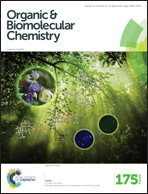Investigation into 9(S)-HPODE-derived allene oxide to cyclopentenone cyclization mechanism via diradical oxyallyl intermediates†
Abstract
The cyclopentane core is ubiquitous among a large number of biologically relevant natural products. Cyclopentenones have been shown to be versatile intermediates for the stereoselective preparation of highly substituted cyclopentane derivatives. Allene oxides are oxygenated fatty acids which are involved in the pathways of cyclopentenone biosynthesis in plants and marine invertebrates; however, their cyclization behavior is not well understood. Recent work by Brash and co-workers (J. Biol. Chem., 2013, 288, 20797) revealed an unusual cyclization property of the 9(S)-HPODE-derived allene oxides: the previously unreported 10Z-isomer cyclizes to a cis-dialkylcyclopentenone in hexane/isopropyl alcohol (100 : 3, v/v), but the known 10E-isomer does not yield cis-cyclopentenone under the same conditions. The mechanism for cyclization has been investigated for unsubstituted and methyl substituted vinyl allene oxide using a variety of methods including CASSCF, ωB97xD, and CCSD(T) and basis sets up to cc-pVTZ. The lowest energy pathway proceeds via homolytic cleavage of the epoxide ring, formation of an oxyallyl diradical, which closes readily to a cyclopropanone intermediate. The cyclopropanone opens to the requisite oxyallyl which closes to the experimentally observed product, cis-cyclopentenone. The calculations show that the open shell, diradical pathway is lower in energy than the closed shell reactions of allene oxide to cyclopropanone, and cyclopropanone to cyclopentenone.


 Please wait while we load your content...
Please wait while we load your content...